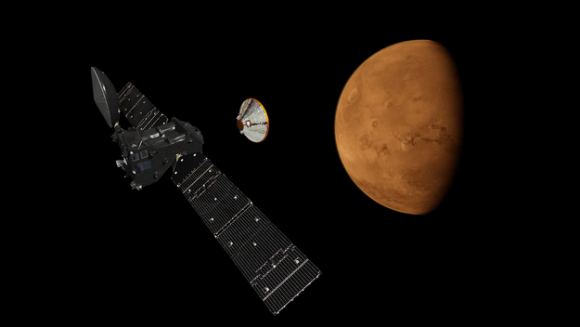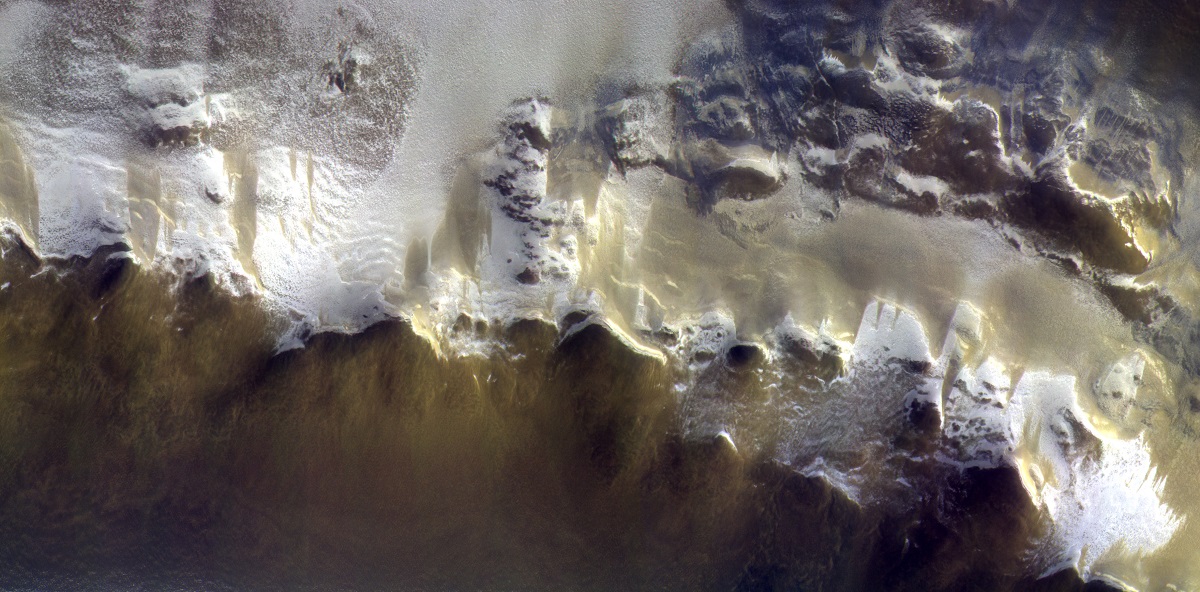On October 19th, 2016, the European Space Agency’s Exobiology on Mars (ExoMars) mission established orbit around Mars. Consisting of the ExoMars Trace Gas Orbiter (TGO) and the Schiaparelli lander, the purpose of this mission is to investigate Mars for past signs of life. And whereas the Schiaparelli unfortunately crashed during deployment, the TGO has managed to begin its mission ahead of schedule.
A few weeks ago, the satellite achieved a near circular orbit around Mars after performing a series of braking maneuvers. Since that time, the orbiter’s Color and Stereo Surface Imaging System (CaSSIS) took a stunning image of the surface. This picture was not only the TGO’s first image of Mars, it was also a test to see if the orbiter is ready to being its main mission on April 28th.
The image captured a 40 km- (25 mi) long segment of the Korolev Crater, which is located high in Mars’ northern hemisphere. The image was a composite of three images in different colors that were taken simultaneously on April 15th, 2018, which were then assembled to produce this color image. The bright material that appears at the edge of the crater is water ice.

As Antoine Pommerol, a member of the CaSSIS science team working on the calibration of the data, explained in a recent ESA press release:
“We were really pleased to see how good this picture was given the lighting conditions. It shows that CaSSIS can make a major contribution to studies of the carbon dioxide and water cycles on Mars.”
Prior to the test phase, the camera team transmitted new software to the TGO, and after a few minor issues, they determined that the instrument was ready to work. The camera is one of four instruments on the TGO, which also carries two spectrometer suites and a neutron detector. The spectrometers began their science mission on April 21st by taking the first sample of the atmosphere to see how its molecules absorb sunlight.
By doing this, the TGO hopes to determine the chemical composition of Mars atmosphere and find evidence of methane and other trace atmospheric gases that could be signatures of active biological or geological processes. Eventually, the camera will help characterize features on the surface that could be related to trace gas sources. Hence the importance of this recent test.

“We aim to fully automate the image production process,” said Nicolas Thomas, the camera’s principal investigator from the University of Bern. “Once we achieve this, we can distribute the data quickly to the science community for analysis.”
A lot of challenges lie ahead, which includes a long period of data collection to bring out the details of rare (or yet to be discovered) trace gases in Mars’ atmosphere. This is necessary since trace gases (as the name would suggest) are present in only very small amounts – i.e. less than 1% of the volume of the planet’s atmosphere. But as Håkan Svedhem – the ESA’s TGO project scientist – indicated, the test image was a good start.
“We are excited to finally be starting collecting data at Mars with this phenomenal spacecraft,” he said. “The test images we have seen so far certainly set the bar high.”
By 2020, the second part of the ExoMars mission is scheduled to launch. This will consist of a Russian surface platform and a European rover landing on the surface in support of a science mission that is expected to last into 2022 or longer. Alongside NASA’s proposed Mars 2020 rover, the Red Planet is due to have several more visitors in the coming years!
Further Reading: ESA

